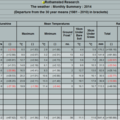Rothamsted Weather Charts
Real-Time Measurement of Climatic Variables.
The ECN Rothamsted automated weather station was established at the Rothamsted Research Harpenden Campus in March 1993 as a stand-a-lone automated weather station (ECN AWS T06 01) adjacent to the main weather station, which was established in 1853. Meteorological Data from ECN AWS T06 01 is available as a cited dataset (1992 to 2015) from the Environmental Information Data Centre (EIDC). At the beginning of 2014 the decision was taken to decommission the ECN AWS (ECN AWS T06 01) and relocate to the existing Rothamsted Met Station, where climatic variables have been measured since 1853. To make the Rothamsted Met Station compatible with the outgoing ECN AWS additional instrumentation was installed. The new location is identified by the code ECN AWS T06 02.
Up until 2003 the Rothamsted Met Station was serviced by a dedicated team of scientists who would go out daily at 09:00 GMT to measure temperature (air and soil), rainfall, drainage, wind speed and wind direction, seven days a week, three hundred and sixty five (six) days a year. In 2004 the Rothamsted Met Station was fully automated with the manual equipment being replaced with a suite of electronic sensors and datalogger with direct access from a desktop computer.
The main change was replacing the standard five inch cylindrical rain gauge (Met Office type MK2) with an aerodynamic tipping bucket rain gauge which unique design reduces wind eddies and loss of water by minimising out-splash and evaporation resulting in higher rain water capture. The gauge we use today is a SBS500 (installed on 10/09/2020) replacing the ARG100.
Please note at times of snowfall rainfall data will not be accurate and depending on rate of thaw may not be recorded on the day it occurred.
The meteorological data presented in the charts below can be obtained from the electronic Rothamsted Archive and the UKCEH Environmental Information Data Centre.
Rothamsted Research has two other meteorological stations at Woburn Farm, Husband Crawley, Bedfordshire and Brooms Barn Research Station, Higham, Suffolk. Data from both these sites are obtainable through the electronic Rothamsted Archive. (These sites are not part of the UK Environmental Change Network)
Click on thumbnails in sections below to see charts (if charts are not up to date then press keys Ctrl and F5 together on keyboard to refresh cache).
The hourly mean or total is graphed (using Genstat 23rd Edition) showing weekly, monthly and yearly summaries and is updated every hour. The yearly summary is graphed against the 30 year mean (1991-2020), based on measurements made at the Rothamsted Meteorological Station, with the variability of the mean being shown using +/- one standard deviation. These graphs are produced from the raw data and are subject to change after quality checks have been carried out.
* Why use a 30 year mean? The following extract was taken from the Met Office web-pages explaining why the long-term mean is averaged over a period of thirty years - "The World Meteorological Organization (WMO) requires the calculation of averages for consecutive periods of 30 years, with the latest covering the 1961-1990 period. However, many WMO members, including the UK, update their averages at the completion of each decade. Thirty years was chosen as a period long enough to eliminate year-to-year variations." Therefore, unless stated, we use the current thirty year mean (1991 to 2020). (REVISED 18/01/2021 previously 1981-2010)
Todays Weather
Today's weather is observed every hour from 00:00 to 24:00 GMT
(to view table of current data click here)
Temperature (mean), degree Celsius (°C): last hour - red column (red value); previous hour - green pointer;
maximum for day - orange pointer; minimum for day - blue pointer.
Rainfall (total), millimetres (mm): hourly and total - blue column (blue value).
Wind Vectors (mean) - Wind Speed, metres/second (m/s) and Direction, degrees (°):
last hour - purple arrow (values within title text, also shows wind speed in miles per hour (mph) and knots (kts); previous hour - blue arrow
Air Temperature
 Monthly: Hourly mean air temperature, °C. (Blue line) .
Monthly: Hourly mean air temperature, °C. (Blue line) .
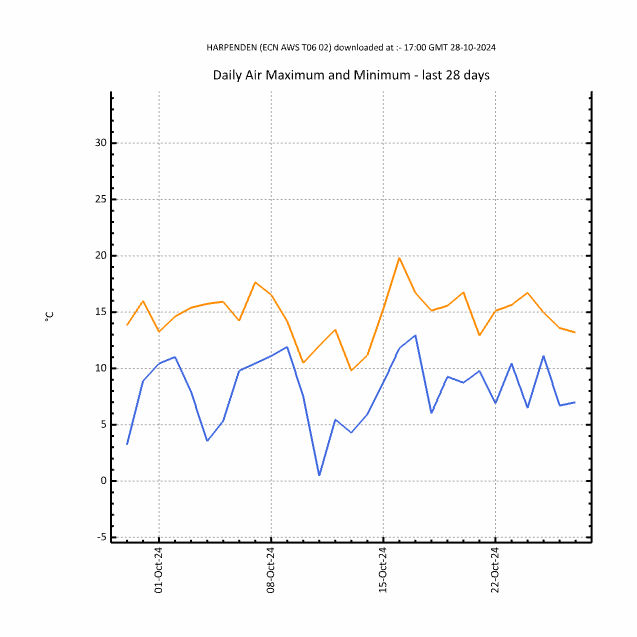 Monthly: Daily maximum air temperature (Orange line) and minimum air temperature (Blue line), °C, are based on hourly mean air temperatures (09:00 to 09:00).
Monthly: Daily maximum air temperature (Orange line) and minimum air temperature (Blue line), °C, are based on hourly mean air temperatures (09:00 to 09:00).
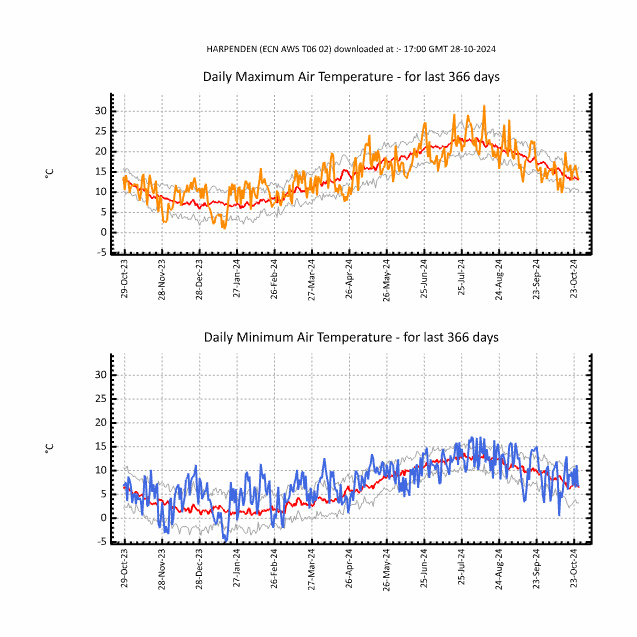 Yearly: Orange Line (Maximum), Blue Line (Minimum): Daily Values, °C; Red Line : 30 year mean, 1991 to 2020; Grey Line : +/- one standard deviation representing the variability of the data used to calculate the thirty year mean.
Yearly: Orange Line (Maximum), Blue Line (Minimum): Daily Values, °C; Red Line : 30 year mean, 1991 to 2020; Grey Line : +/- one standard deviation representing the variability of the data used to calculate the thirty year mean.
Wind Vectors
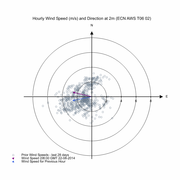 Monthly: For weekly and monthly charts of wind vectors the most recent and penultimate wind speed and direction records are indicated by the purple and blue arrows, respectively. The arrows indicate the direction (°) from which the wind comes from. Earlier records are displayed using open circles. Data points are the average wind speed (m/s) for a given direction (averaged) over a one-hour period. The x- and y- axes represent wind direction and the distance of each point from the origin represents wind speed (concentric circles denote the wind speed intervals, m/s).
Monthly: For weekly and monthly charts of wind vectors the most recent and penultimate wind speed and direction records are indicated by the purple and blue arrows, respectively. The arrows indicate the direction (°) from which the wind comes from. Earlier records are displayed using open circles. Data points are the average wind speed (m/s) for a given direction (averaged) over a one-hour period. The x- and y- axes represent wind direction and the distance of each point from the origin represents wind speed (concentric circles denote the wind speed intervals, m/s).
 Yearly: Annual wind data are summarised on a rose diagram showing the distribution of winds according to their speed (m/s) and direction (°). Wind records are grouped by direction into 22.5° circular segments each with radius (length) corresponding to the number of wind records in the segment (expressed as a percentage of the 365 daily observations represented). Wind speeds are categorised according to the 'Key' (lower right-hand scale) and the proportion of all records of each speed occurring within each segment are denoted using the appropriate colours.
Yearly: Annual wind data are summarised on a rose diagram showing the distribution of winds according to their speed (m/s) and direction (°). Wind records are grouped by direction into 22.5° circular segments each with radius (length) corresponding to the number of wind records in the segment (expressed as a percentage of the 365 daily observations represented). Wind speeds are categorised according to the 'Key' (lower right-hand scale) and the proportion of all records of each speed occurring within each segment are denoted using the appropriate colours.
Rainfall
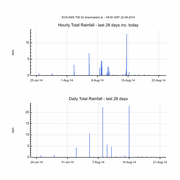 Monthly: Hourly data: total rainfall, mm, in an hour
Monthly: Hourly data: total rainfall, mm, in an hour
Daily data: total rainfall, mm (09:00 to 09:00).
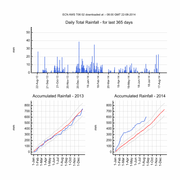 Yearly: Blue Line: Daily rainfall, mm (09:00 to 09:00) and Accumulated daily rainfall, mm ; * Red Line: accumulated daily rainfall, 30 year mean (1991 to 2020 previously 1981-2010); Grey Line : +/- one standard deviation representing the variability of the data used to calculate the thirty year mean.
Yearly: Blue Line: Daily rainfall, mm (09:00 to 09:00) and Accumulated daily rainfall, mm ; * Red Line: accumulated daily rainfall, 30 year mean (1991 to 2020 previously 1981-2010); Grey Line : +/- one standard deviation representing the variability of the data used to calculate the thirty year mean.
* The thirty year mean (1991 to 2020) for rainfall should be used only for guidance. During this period rainfall was measured using the the two different styles of rain gauges as mentioned above.
Solar Radiation
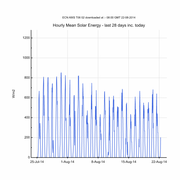 Monthly: Blue Line: hourly mean solar radiation, watts/m2.
Monthly: Blue Line: hourly mean solar radiation, watts/m2.
 Yearly: Blue Line : Mean Daily Values, watts/m2 (00:00 to 24:00 GMT); Red Line : 30 year mean, 1991 to 2020 (previously 1981-2010); Grey Line : +/- one standard deviation representing the variability of the data used to calculate the thirty year mean.
Yearly: Blue Line : Mean Daily Values, watts/m2 (00:00 to 24:00 GMT); Red Line : 30 year mean, 1991 to 2020 (previously 1981-2010); Grey Line : +/- one standard deviation representing the variability of the data used to calculate the thirty year mean.
Soil Temperature at 10cm under bare soil
 Monthly: Blue Line: hourly mean soil temperature at 10cm below bare soil.
Monthly: Blue Line: hourly mean soil temperature at 10cm below bare soil.
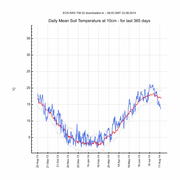 Yearly: Blue Line: Daily Values; Red Line: 30 year mean, 1991 to 2020 (previously 1981-2020); Grey Line : +/- one standard deviation representing the variability of the data used to calculate the thirty year mean.
Yearly: Blue Line: Daily Values; Red Line: 30 year mean, 1991 to 2020 (previously 1981-2020); Grey Line : +/- one standard deviation representing the variability of the data used to calculate the thirty year mean.
Soil Temperature at 30cm under grass
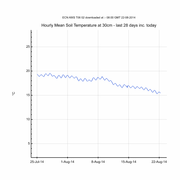 Monthly: Blue Line: hourly mean soil temperature at 30cm below grass.
Monthly: Blue Line: hourly mean soil temperature at 30cm below grass.
 Yearly: Blue Line: Daily Values; Red Line: 30 year mean, 1991 to 2020 (previously 1981-2010); Grey Line : +/- one standard deviation representing the variability of the data used to calculate the thirty year mean.
Yearly: Blue Line: Daily Values; Red Line: 30 year mean, 1991 to 2020 (previously 1981-2010); Grey Line : +/- one standard deviation representing the variability of the data used to calculate the thirty year mean.

